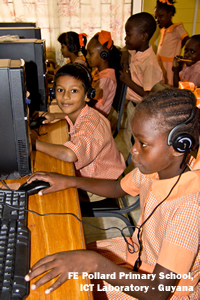The spreadsheet functionality allows course planners to “balance” desired competencies accurately with the available contact/notional hours, in this instance sixty notional hours for Technology Literacy and ninety hours for Knowledge Deepening. Strip out the Guyana detail for a clean template to start your own mapping.
| Curriculum Map Template: Guyana ICT in Education for Teachers Course [ |
2.5 Teacher Basic ICT Readiness Assessment Tool
In one particular context, a method was needed to determine whether nominated school teachers were likely to encounter success in the various ICT in education professional development training initiatives described below. This was necessary because most courses aimed at encouraging the use of ICT in teaching require proficiency levels above those of a first-time user. This test is disarmingly simple, yet effective and easy to implement. The test also comes with setup instructions, an assessment protocol, and a marking memo. It is designed to be administered by school personnel and can easily be adapted.
| Teacher Basic ICT Readiness Assessment Tool [ |
2.6 ICT in Education for Teachers Course and Materials
Through the implementation of country-specific activities, we discovered the value in using a course development model that is more closely aligned with web development approaches than with traditional publishing models. This allows for a shorter time to initial deployment, entails regular iterations of design and testing, and encourages more frequent versioning of courses. It is also much cheaper than traditional courseware development. (See Appendix A for a more detailed description.) Using this approach after one  has mapped the curriculum focus turns to developing ICT in education course materials and training guides using free and open resources. The advantage here is that by building wraparound guides to existing materials and keeping repurposing to a minimum, these courses can be developed cost-effectively and over a relatively short period. An entire programme can be “assembled” at very little cost.
has mapped the curriculum focus turns to developing ICT in education course materials and training guides using free and open resources. The advantage here is that by building wraparound guides to existing materials and keeping repurposing to a minimum, these courses can be developed cost-effectively and over a relatively short period. An entire programme can be “assembled” at very little cost.
As a consequence of the work in Guyana, however, there is now a set of assembled courses already comprised of OER, which can be further refined and adapted in new contexts (as has recently been done by the Sampoerna School of Education in Indonesia, for example). Adapting an existing course makes it even quicker for derivative programmes to be deployed. Developed by adapting OER and aligned closely with the UNESCO ICT-CFT, this set of ICT in education units provides the substance for context-relevant teacher professional development. The course also includes facilitation notes for facilitators new to the field of ICT in education. The course has been made available under a Creative Commons Attribution license, which allows repurposing, and can be used as a starting point for the development of new courses in different countries. It exists in both paper and electronic formats, and has been designed to work in low-tech environments where connectivity is not robust.